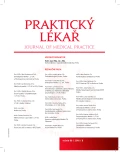Cholesterol myths
Authors:
J. Brát 1; O. Herber 2
Authors‘ workplace:
Vím, co jím a piju o. p. s., Praha
Ředitelka: Lucie Gonzálezová
1; Ústav všeobecného lékařství 1. LF UK, Praha
Přednosta: doc. MUDr. Bohumil Seifert, Ph. D.
2
Published in:
Prakt. Lék. 2016; 96(6): 280-284
Category:
Of different specialties
Overview
Cholesterol is a highly discussed topic nowadays. Risks related to an unbalanced diet and nutrition are catching the attention of professionals and non-professionals alike. Internet sources, however, often confuse the reader by providing incomplete and out-of-context information. The complexity of lipidology is not going to become more understandable when technical terminology, especially in abbreviated form, is used. The text contains explanations of related terms as well references to professional sources comparing evidence-based information. Having the knowledge about the complete nutritional composition of diet can be an important strategy during the prevention of cardiovascular diseases, rather than the unproven reduction of particular nutrients.
Keywords:
cholesterol myths – blood lipids – saturated fatty acids – polyunsaturated fatty acids – dietary habits – glycemic index
Sources
1. German JB, Gibson RA, Krauss RM, et al. A reappraisal of the impact of dairy foods and milk fat on cardiovascular disease risk. Eur J Nutr 2009; 48: 191–203.
2. Hu FB, Stampfer MJ, Manson JE, et al. Dietary fat intake and the risk of coronary heart disease in women. N Engl J Med 1997; 337(21): 1491–1499.
3. Chowdhury R, Warnakula S, Kunutsor S, et al. Association of dietary, circulating, and supplement fatty acids with coronary risk. Ann Intern Med 2014; 160: 398–406.
4. Jakobsen MU, O’Reilly EJ, Heitmann BL, et al. Major types of dietary fat and risk of coronary heart disease: a pooled analysis of 11 cohort studies. Am J Clin Nutr 2009; 89(5): 1425–1432.
5. Jakobsen MU, Dethlefsen C, Joensen AM, et al. Intake of carbohydrates compared with intake of saturated fatty acids and risk of myocardial infarction: importance of the glycemic index. Am J Clin Nutr 2010; 91(6): 1764–1768.
6. Lorenzen JK, Søren K, Jensen SK, Astrup A. Milk minerals modify the effect of fat intake on serum lipid profile: results from an animal and a human short-term study. Br J Nutr 2014; 111: 1412–1420.
7. Mensink RP, Zock PL, Dester ADM, et al. Effects of dietary fatty acids and carbohydrates on the ratio of serum total to HDL cholesterol and on serum lipids and apolipoproteins: a meta-analysis of 60 controlled trials. Am J Clin Nutr 2003; 77: 1146–1155.
8. Nordic Council of Ministers. Nordic Nutrition Recommendation 2012 [online]. Dostupné z http://norden.diva-portal.org/smash/get/diva2:704251/FULLTEXT01.pdf.
9. Ras RT, Demonty I, Zebregs YEMP, et al. Low doses of eicosapentaenoic acid and docosahexaenoic acid from fish oil dose-dependently decrease serum triglyceride concentrations in the presence of plant sterols in hypercholesterolemic men and women. J Nutr 2014; 144(10): 1564–1570.
10. Reiner Ž, Catapano AL, De Backer G, et al. ESC/EAS Guidelines for the management of dyslipidaemias 2011. Eur Heart J 2011; 32: 1769–1818.
11. Siri-Tarino PW, Sun Q, Hu FB, Krauss RM. Meta-analysis of prospective cohort studies evaluating the association of saturated fat with cardiovascular disease. Am J Clin Nutr 2010; 91: 535–546.
12. Siri-Tarino PW, Sun Q, Hu FB, Krauss RM. Saturated fatty acids and risk of coronary heart disease: modulation by replacement nutrients. Curr Atheroscler Rep 2010; 12: 384–390.
13. Te Morenga L, Mann J, Skeaff M, et al. Letters to the Editors. Comments and response: Association of dietary, circulating, and supplement fatty acids with coronary risk. Ann Intern Med 2014; 161: 453–459.
14. Wolfram G, Bechthold A, Boeing H, et al. Evidenzbasierte Leitlinie. Fettzufuhr und Prävention ausgewählter ernärungsmitbedingter Krankheiten. Bonn: DGE 2015.
Labels
General practitioner for children and adolescents General practitioner for adultsArticle was published in
General Practitioner

2016 Issue 6
Most read in this issue
- Hospitalism in pediatric patients
- Cholesterol myths
- Complex rehabilitation of patients after stroke – project of Stroke centre in Thomayer’s hospital
- Hygiene hypothesis and the increasing incidence of allergic diseases in the children and adolescent population
